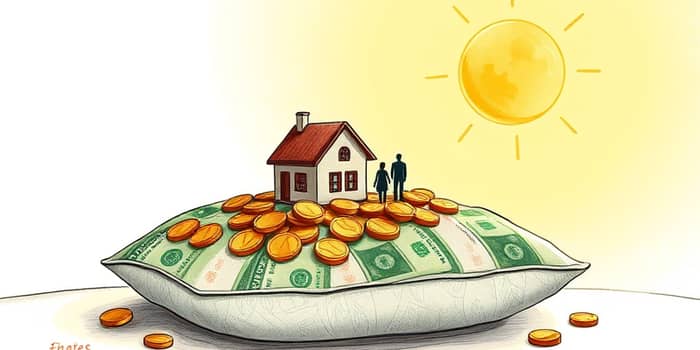Building a robust emergency fund isn’t just about saving—it’s about creating comprehensive financial safety net that can carry you through unexpected storms. In this guide, we’ll explore how to accurately calculate your three-month cushion, identify all relevant expenses, and develop strategies to build and maintain your reserve over time.
Understanding the Purpose of an Emergency Fund
An emergency fund serves as a financial safeguard designed to cover sudden expenses, such as medical bills, car repairs, or job loss. By setting aside a dedicated pool of money, you avoid relying on high-interest debt and preserve your long-term financial goals.
Beyond covering costs, having an emergency fund provides peace of mind and stability in uncertainty. You’ll sleep better knowing that life’s surprises won’t derail your financial health or force you to liquidate long-term investments at a loss.
Comprehensive Expense Calculation Framework
To build a true three-month cushion, start by listing every monthly expense you can think of. Be thorough—omitting small recurring charges can leave you short when you need it most.
- Housing payments (rent or mortgage, including taxes and insurance)
- Utilities (electricity, water, gas, sewage)
- Telecommunications (internet, phone services)
- Insurance premiums (health, auto, home/renters)
- Transportation costs (fuel, maintenance, public transit)
- Debt obligations (minimum credit card, loan payments)
- Food (groceries and essential dining out)
- Other necessities (childcare, medications, work-related costs)
Once you’ve tallied these, you’ll have a clear picture of your baseline outflow each month. This forms the foundation for multiplying by three and tailoring adjustments based on your personal situation.
Step-by-Step Calculation Methodology
Following a structured approach ensures no detail is overlooked. By breaking the process into clear steps, you transform a daunting task into manageable actions.
- Identify and total all monthly living expenses
- Multiply the sum by three for a basic cushion
- Consider adjustments for income variability or lifestyle changes
After this step-by-step process for calculating funds, review your sum and reflect on potential irregular costs—annual insurance premiums, registration fees, or seasonal maintenance. Adjust your target cushion accordingly before setting your savings goal.
Starting Small and Staying Motivated
For many, a full three-month fund can feel out of reach. Begin with a smaller, more attainable target—perhaps $500 or one month’s expenses. Celebrate each milestone to keep your momentum.
Adopt strategies like automated transfers or rounding up purchases to the next dollar. Over time, gradual contributions add up over time, transforming small deposits into a substantial nest egg without overwhelming your budget.
Optimal Places to Keep Your Emergency Fund
Your emergency fund must balance accessibility and earning potential. A fully accessible high-yield savings account is often the best home, offering immediate liquidity while earning interest rates well above traditional checking accounts.
Alternatively, money market accounts or short-term certificates of deposit (CDs) can provide slightly higher yields, though you should ensure penalties for early withdrawal don’t impede access in a true emergency.
Real-Life Scenarios and Illustrations
Understanding how your emergency fund functions in practical terms helps illustrate its value. Consider three common situations:
With a table like this, you can see how a properly sized cushion prevents debt accumulation and provides breathing room. Each scenario underscores the importance of anticipating a range of unpredictable events.
Adjusting Your Cushion for Personal Circumstances
The standard three-month recommendation is a solid starting point, but personal factors may warrant more or less. If you have irregular income, consider a six-month cushion. Families with young children or health challenges may require additional reserves to cover specialized care.
Other adjustment factors include existing insurance coverage, spousal income, and your overall risk tolerance. Revisit your target annually or after major life changes—moving, career shifts, or welcoming a new family member.
Maintaining, Replenishing, and Evolving Your Fund
Once you tap your emergency fund, make replenishing it a top priority. Treat repayments to your cushion as non-negotiable monthly expenses, just like rent or utilities.
As your career advances and expenses shift, periodically reassess your needs. You might increase your cushion as income grows or streamline contributions when other goals demand focus. This evolving approach keeps your fund aligned with your life’s trajectory.
Finally, leverage online resources—budgeting apps and tailored emergency fund calculators—to simplify tracking and forecasting. By combining disciplined planning with adaptable strategies, you’ll cultivate a resilient financial foundation ready for any surprise life brings.
References
- https://www.nerdwallet.com/article/banking/emergency-fund-calculator
- https://www.pnc.com/en/calculators/investments-and-retirement/safety-net-calculator.html
- https://www.practicalmoneyskills.com/en/resources/financial-calculators/budget-goals/emergency-fund.html
- https://www.navyfederal.org/makingcents/tools/emergency-fund-calculator.html
- https://www.statefarm.com/simple-insights/financial/building-an-emergency-fund-calculate-how-much-to-save
- https://www.sofi.com/calculators/emergency-fund-calculator/
- https://www.westernsouthern.com/personal-finance/emergency-fund-calculator
- https://www.consumerfinance.gov/an-essential-guide-to-building-an-emergency-fund/










